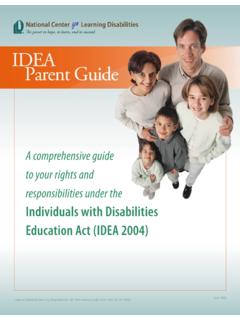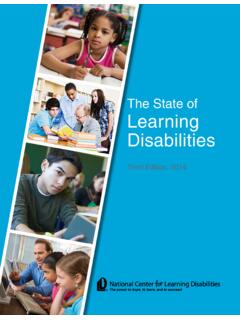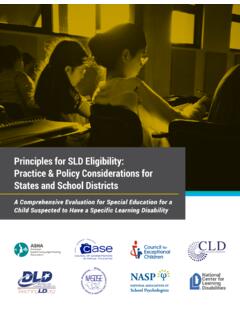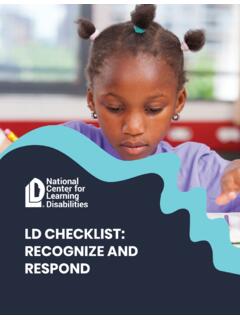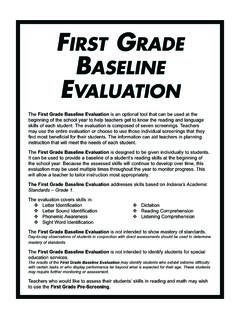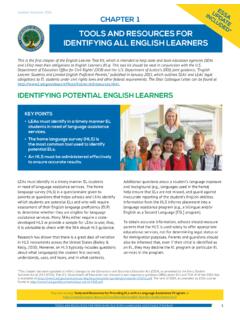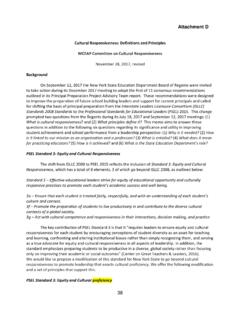Transcription of NCLD Disproportionality Trends and Actions for Impact Final
1 Significant Disproportionality in Special Education: Current Trends and Actions for Impact Years of research point to inequities in education for students of color, students from low-income backgrounds, and students with disabilities. These inequities are particularly apparent when it comes to rates of discipline and special education enrollment. The term significant Disproportionality is used to describe the widespread trend of students of certain racial and ethnic groups being identified for special education, placed in more restrictive educational settings, and disciplined at markedly higher rates than their peers. Due to bias within the education system (including within assessments and academic and other policies), students of color can be misidentified as needing special education, and are then placed in more restrictive settings and experience harsher discipline because of the intersectionality of race and special education.
2 Being misidentified as needing special education, placed in a restrictive setting, or disciplined more frequently and harshly can negatively affect student outcomes. It is imperative that education professionals and policymakers understand the magnitude of significant Disproportionality for students of different races and ethnicities and take Actions to correct it and prevent it from happening. This brief summarizes the literature and latest research on Disproportionality in special education and offers changes in policy and practice that can reduce significant Disproportionality in schools. NCLD | Significant Disproportionality in Special Education: Current Trends and Actions for Impact | Page 1. The Three Components of Disproportionality Significant Disproportionality refers to three separate but related Trends that Impact a student's educational experience: (1) identification for special education (also called eligibility); (2) educational placement (once identified as eligible for special education); and (3) discipline.
3 Special education identification The most often discussed pattern of significant Disproportionality is the overrepresentation of students of color in special education. students of color, with the exception of Asian students , are identified for special education at a higher rate than their White peers. American Indian and Alaska Native children receive special education at twice the rate of the general student population, and Black students are 40 percent more likely to be identified with a disability versus all other Hispanic,5 Black, and Native students all have higher risk ratios for being identified with disabilities than White The overrepresentation of children in special education programs causes short-term and long-term harm, specifically for students of color.
4 Figure 1. Risk ratios for students ages 6 through 21 served under the Individuals with Disabilities Education Act (IDEA), Part B, within racial/ethnic groups: Fall American Indian/Alaska Native Asian RACIAL/ETHNIC GROUP. Black/African American Hispanic/Latino 1. Native Hawaiian/Other White Two or more races 1. Some researchers argue that disparities in identification rates exist because students of color actually do experience disability at a higher rate than their White peers, and that these students are actually underrepresented in special education based on their significant level of This theory rests in part on the fact that race and income in the United States are highly correlated. According to the National Survey of Children's Health, children living at or below the federal poverty level are more than twice as likely to be identified with specific learning disabilities (SLD) as children in households with income four times the poverty Poverty has been tied to outcomes that are sometimes risk factors for disability such as low birth weight and exposure to lead10 and a higher likelihood of having adverse childhood experiences (ACEs).
5 students who experience four or more ACEs have been found to be 32 times more likely to be diagnosed with learning or behavioral challenges.. Adverse Childhood Experiences (ACEs) include:13. Economic hardship Divorce or separation of a parent Death of a parent Parent served time in jail Witnessing adult domestic violence Victim or witness to neighborhood violence Living with someone who was mentally ill or suicidal Living with someone with an alcohol or drug problem Being treated or judged unfairly due to race/ethnicity NCLD | Significant Disproportionality in Special Education: Current Trends and Actions for Impact | Page 2. However, a great deal of recent evidence points to the troubling existence of systemic racial biases in our schools and communities that lead to students of color being identified for special education at higher rates.
6 Research by Grindal et al., 2019, has demonstrated that while both race and income play a role in identification disparities, income itself does not fully explain the patterns of identification . Specifically, when looking at students within the same income bracket ( , comparing only students from low-income backgrounds across races, or comparing only students from non-low-income backgrounds across races), Black and Hispanic students are more likely to be identified for special education, compared to White For example, in their study, Black students from non-low-income backgrounds had about twice the likelihood of being identified with intellectual disabilities (ID) or emotional disturbances (ED), compared to White students from non-low-income backgrounds in the states Disability Categories Recognized by IDEA.
7 1. Specific learning disability (SLD) includes learning disabilities in reading (dyslexia), math (dyscalculia), and writing (dysgraphia) and makes up approximately 37% of all students with disabilities 2. Speech or language impairment (SLP) includes difficulties such as stuttering, pronunciation, or other expressive language issues and makes up approximately 17% of all students with disabilities 3. Other health impairment (OHI) includes ADHD and other medical conditions and makes up approximately 16% of all students with disabilities 4. Autism spectrum disorder (ASD) is a developmental disability that mainly affects a child's social and communication skills and makes up approximately 10% of all students with disabilities 5. Intellectual disability (ID) is a disability characterized by below-average intellectual ability and may include poor communication, self-care, and social skills and makes up approximately 7% of all students with disabilities 6.
8 Emotional disturbance (ED) includes disorders such as anxiety disorder, schizophrenia, bipolar disorder, and depression and makes up approximately 5% of all students with disabilities 7. Developmental delay includes delays in physical, cognitive, social, emotional, or behavioral development up to age 9 and makes up approximately 3% of all students with disabilities 8. Multiple disabilities includes more than one disability type and makes up approximately 2% of students with disabilities 9. Hearing impairment includes difficulties with hearing that do not include deafness and makes up approximately 1% of students with disabilities 10. Orthopedic impairment includes difficulties with physical functioning or bodily control, including cerebral palsy, and makes up less than 1% of students with disabilities 11.
9 Traumatic brain injury includes disabilities caused by brain injury and physical force and makes up less than 1% of students with disabilities 12. Visual impairment includes blindness or eyesight problems and makes up less than 1% of students with disabilities 13. Deafness includes a lack of hearing even with hearing aids*. 14. Deaf-blindness includes co-occurring hearing and visual impairments and makes up less than 1% of students with disabilities *No data is reported by the Department of Education on this specific category. See IDEA Section 618. Data Products: Static Tables at #partb-cc. NCLD | Significant Disproportionality in Special Education: Current Trends and Actions for Impact | Page 3. The magnitude of these identification disparities is greatest for those disabilities that experts say are more subjective.
10 We would consider disabilities affecting vision or hearing to be objective in nature, because there is a clear root cause and a definitive assessment that can tell you whether and to what degree a student's vision or hearing is impacted without the possibility of bias. Subjective disabilities are those for which non-subjective tests are not available, meaning that identification depends on the professional judgment and potentially the biases of the assessors. For example, SLD, ID, and ED are considered to be more subjective American Indian/Alaska Native students are almost twice as likely to receive services for SLD, compared to White students . Black students are more than twice as likely to be identified with ID as their While researchers have suggested that teacher or assessment biases could have greater impacts on the determination of these disabilities, leading to the observed disparities, more research is Although IDEA affords students with disabilities many essential protections and gives them access to specialized instruction and related services to address their needs, special education is not an adequate solution nor equitable for students who do not actually have a disability.
